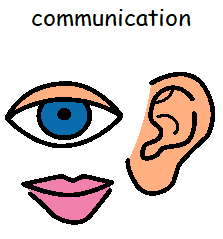 Communication
Communication
At Rosslyn we use a range of different communication methods to meet the needs of an individual learner.
Objects of Reference
An object of reference is any object which can be used to represent an activity, place or person. Objects of reference are used with learners who have a multi-sensory impairment and difficulty understanding spoken words, signs, symbols or photographs. Understanding real objects is the first stage of symbolic development and using them helps to support the understanding of spoken words. Over time a learner will understand that the object stands for a specific activity, place or person. Objects of reference can signal the start of an activity, be used to make a choice or enable a learner to request an item/activity.
Here are some examples of the OOR we use at Rosslyn.

Art – Paintbrush
Cooking – Whisk
Office – Stapler
PE – Squistle
Shopping – Coin Purse
Swimming – Arm Band
Movement, Gesture and Sign
This system is for learners who have no or limited vision, and have complex needs. The signer needs to be sensitive to touch, telling the learner what they are going to be touching if possible. For example:
“I’m going to lift you hand and say hello, here I come”
The signer will use their voice to build anticipation of touch by elongating words and adjusting their tone and pitch.
Signs often have an audio cue that support the learner with more information:
Eat – “Mmmmmm” sound
Some signs have a sensory cue:
Swimming – flurries of air can be felt around the face
Initially the signer will sign on the learner. As the learner demonstrates some progress they will be encouraged to sign co-actively, with a view that they will be able to use the sign independently if they have the gross motor skills required.
Examples of MSG are on the SWAY in the Signalong section below.
Signalong
Signalong is used to teach language for learners with complex needs. It is used widely and not restricted to those who have a hearing impairment. Signing helps learners focus on the key words, and process the information as the word is visual. For example, the word ‘drink’ takes about 1 second to say, but the sign takes 3 or 4 seconds and can ‘freeze’ or be repeated to ensure the learner has understood the language. Signalong is a simplified version of Makaton and does not use any letters as spelling words relies on a learner having some awareness of the alphabet.
For more information – www.signalong.org.uk
Here is a Signalong SWAY document when a range of signs you can learn –https://sway.office.com/6MRSCYFwz2zwMUny?ref=email
PECS
PECS is a unique alternative/augmentative communication system. Our staff use this system on a daily basis with our learners and several staff members are specially PECS trained.
The main aim of PECS is to teach functional communication. It has six phases and begins by teaching an individual to give a single picture of a desired item or action to their learning partner, who will immediately respond to the request. The system goes on to teach discrimination of pictures and how to put them together in sentences.
For more information click https://pecs-unitedkingdom.com/pecs/

AAC Devices
Augmentative and Alternative Communication (AAC) covers a huge range of techniques that support or replace spoken communication. AAC is a range of strategies and tools from signing or picture boards, as discussed above, to sophisticated computer technologies. AAC helps someone to communicate as effectively as possible, in as many situations as possible. AAC is a type of Assistive technology that covers electronic speech aids, which uses augmented voices to vocalise word selections, phrases or even sentences for those using the devices. These devices replace someone’s speech when they are non-verbal or can make communicating for those with incoherent speech, a bit easier. There are lots of different types of AAC including Grid pads, Eye Gaze Technology, and even software for iPads and computers, that act as communication aids for people with disabilities.

